Methi paratha is a healthy tasty whole wheat flatbread made with fenugreek leaves. These Methi ke Parathe are packed with flavor and nutrition. Plus they are a great healthier alternative to plain Paratha. Cook this methi paratha recipe in 30 minutes (if you have prepped methi leaves) and serve with curd, pickles, and curries!
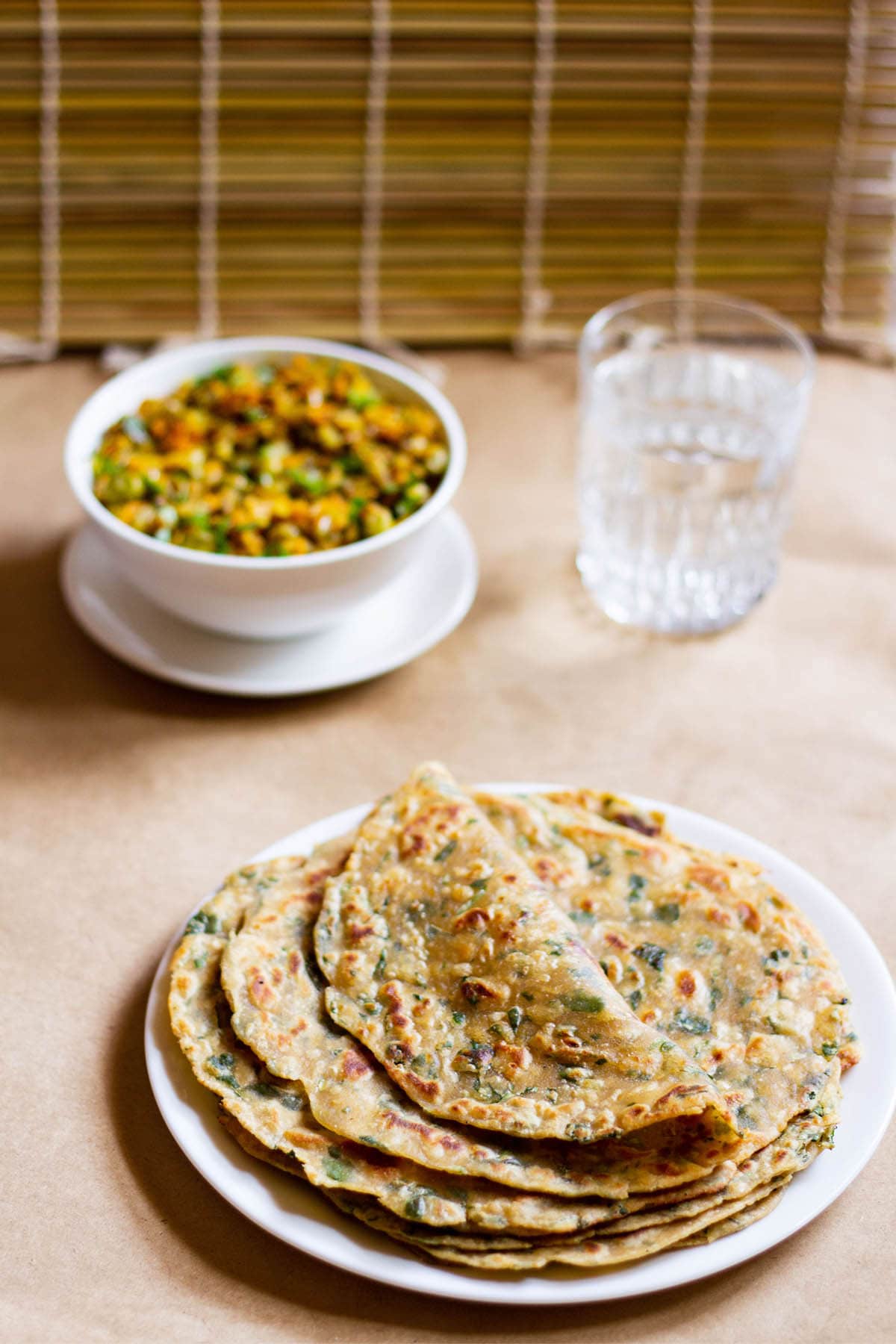
About This Methi Paratha Recipe
Methi paratha are whole some flatbreads from unleavened whole wheat dough featuring fenugreek leaves, herbs and spices. These healthy flatbreads are also known as “methi ke parathe” or “methi roti”.
Crispy and soft, these parathas have a lovely fragrant aroma and a light bitterness of the fenugreek leaves. They are a quick and healthy breakfast or side that can be eaten with any Indian curry or sabzi.
Fenugreek a.k.a methi leaves are easily found in India and I often end up making lots of dishes using it. When living in Bangalore, we would grow fenugreek leaves in our balcony.
I would often add the fenugreek micro greens to salads and also make a variety of methi recipes from the fully grown harvested leaves. If you have a balcony, terrace garden or a herb garden, then try growing fenugreek.
Another mouth-watering addition to this paratha is garlic. The fenugreek and garlic complement each other so well and both awesome flavors come through when eating the paratha.
In North India, methi ke parathe are made for breakfast or packed in a tiffin box. We like to eat these at any time of the day. So I make them for breakfast, lunch, or at times for dinner.
I usually accompany these methi roti with a dry veggie curry, sweetened curd, or pickle. Some people like to have methi ka paratha with plain curd, mango pickle, lemon pickle, or green chili pickle. It is completely up to you!
2 Ways To Reduce Bitterness in Methi
Methi leaves have a fragrant flavor with a faint bitter taste. The bitterness is not overwhelming to your palate. It is a fragrant light bitterness that you may like if you have not grown up eating fenugreek.
Sometimes the fenugreek leaves can be highly bitter. Follow either of the two methods listed below to reduce the bitterness in the leaves.
- Mix some salt with the rinsed fenugreek leaves. Set aside for 15 to 20 minutes. Rinse the leaves a few times and drain the water.
- Blanch the methi leaves in boiling salted water for about a minute. Drain, rinse with fresh water, and use.
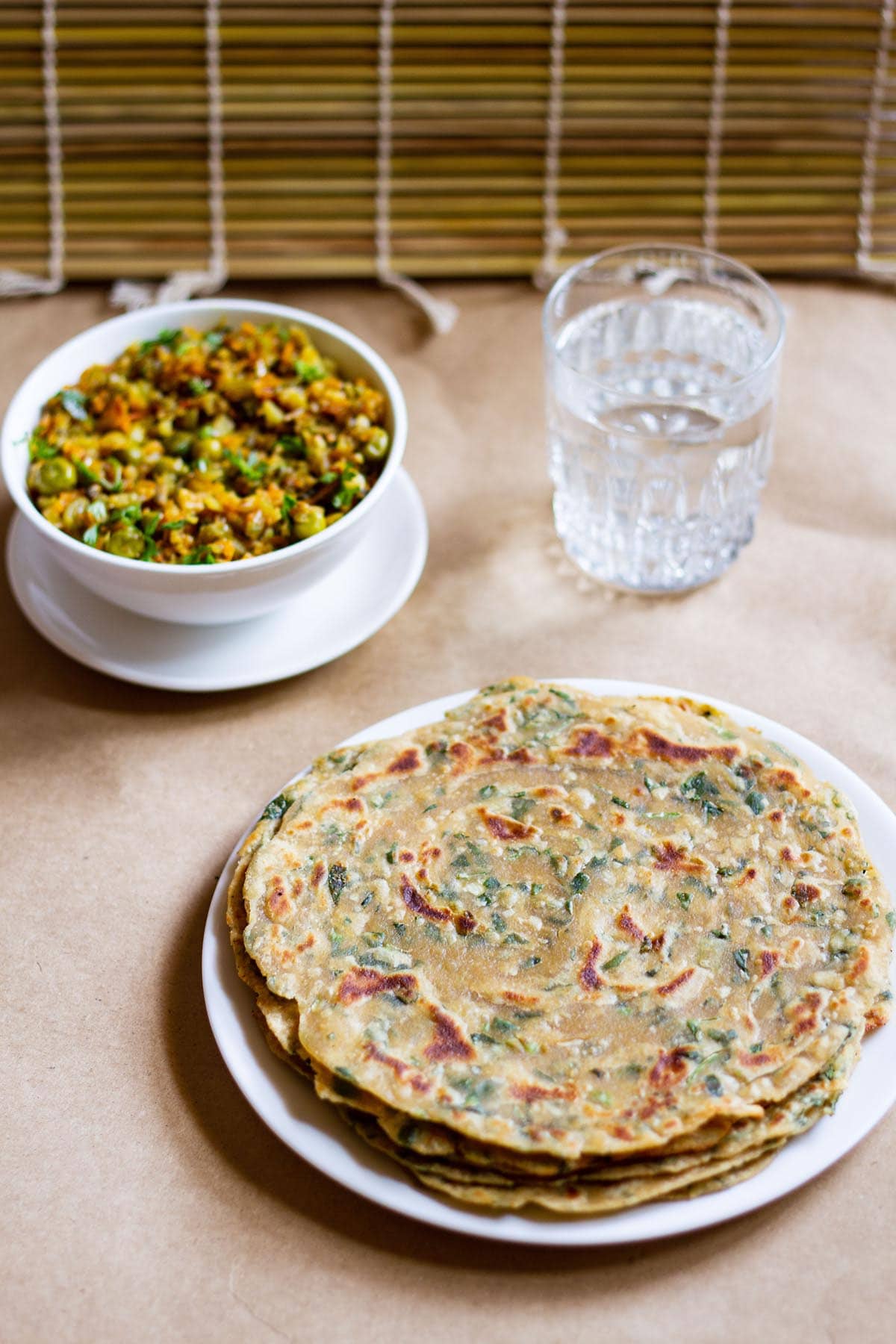
How to Make Methi Paratha
Prepare Methi Leaves
Before you begin making methi paratha recipe, you need to prep the leaves. So lets begin.
1. If you buy the fenugreek from the market, first pluck about 1 cup of methi leaves. Then in a bowl, soak the plucked leaves with enough water, 1 tablespoon vinegar and ½ teaspoon baking soda for about 3 to 4 minutes. Gently mix. The baking soda and vinegar gets rid of pesticides from the leaves.
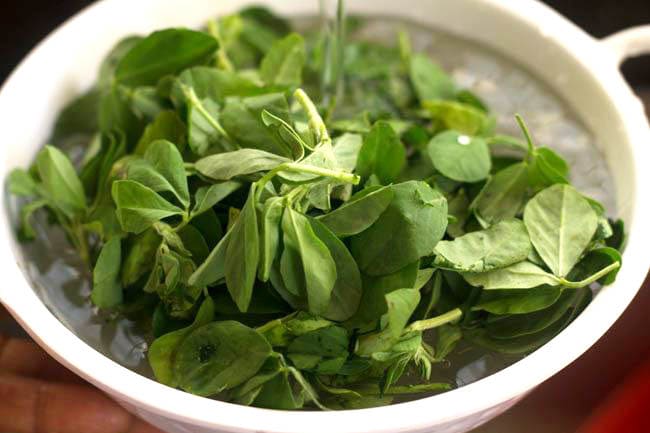
2. Drain this water using a colander.
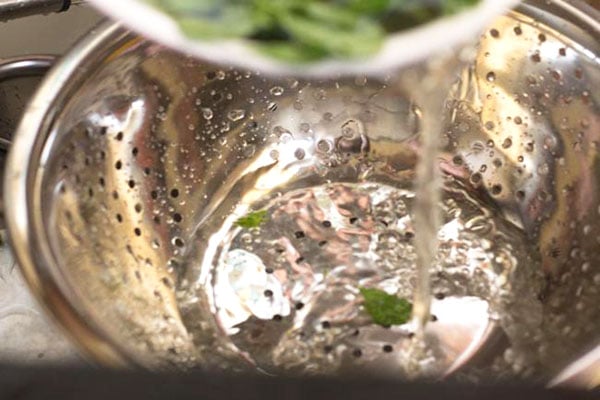
3. Soak the leaves again in fresh clean water in a bowl for a couple of minutes. Later move the methi leaves gently in the water. This will remove any soil or mud particles that are on the stems or leaves.
Drain the water. You can repeat this process once or twice or opt to thoroughly rinse the leaves under running water for a few times. Finally, drain all the water.
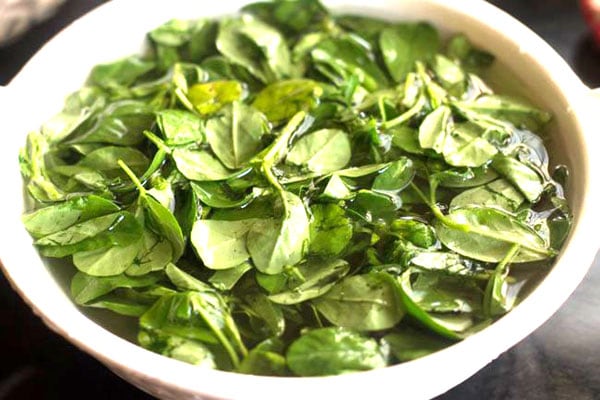
4. Place the leaves on a kitchen towel and spread them evenly on it for a few minutes or you can proceed to chopping them.
Another method is to use a wired rack and place the leaves on it. Keep a tray below the wired rack to collect any water droplets. Finely chop the leaves and set aside.
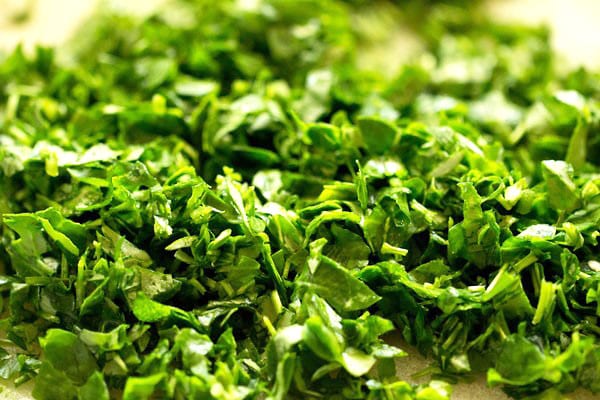
Knead Dough
In a bowl add 2 cups of whole wheat flour and ½ teaspoon salt or as required. Add the chopped fenugreek leaves, ½ to 1 teaspoon chopped green chilies (1 to 2 green chillies), 1.5 teaspoons of finely chopped garlic and 2 teaspoons oil.
Use a stand-mixer for kneading the dough if you have it.
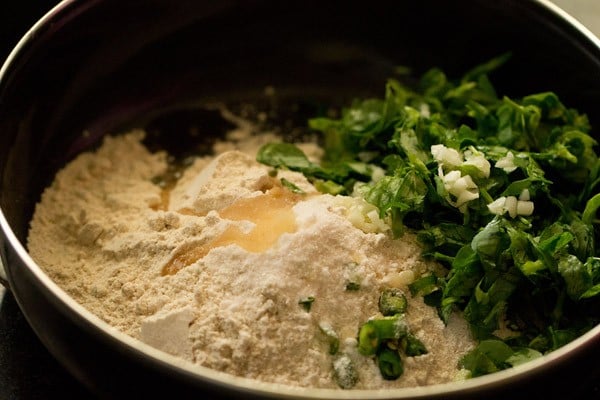
2. Pour ⅓ cup of water bit by bit. Do not add all the water at once. Add a portion of water as you go on working on the dough. The fenugreek leaves will release a good amount of water, so take a note of this while kneading.
Keep in mind that the water proportion will vary with the water content in the fenugreek leaves and the type, variety of wheat flour.
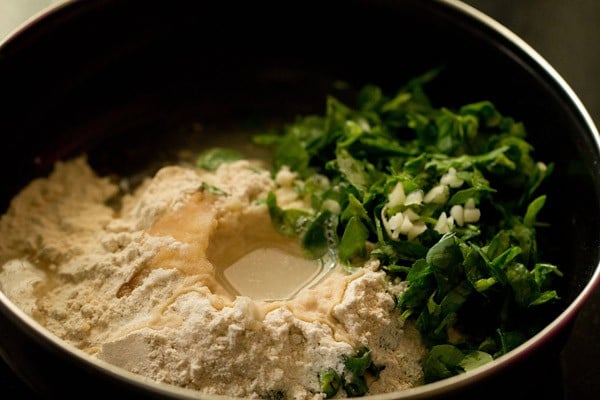
3. First mix and then start to knead the dough. Add water as needed when you go about kneading the dough.
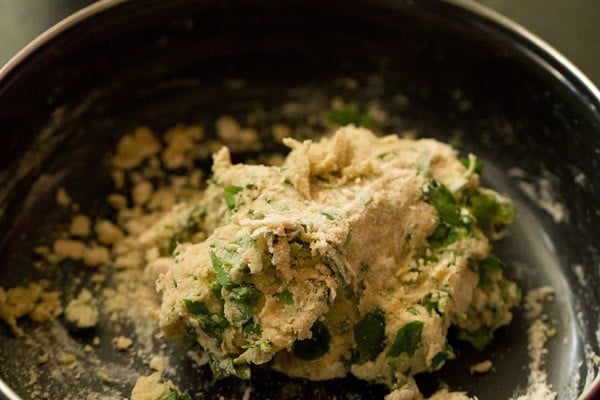
4. Knead the mixture into a smooth, soft and pliable dough. Add more water if required while kneading.
Tip 1: If the dough feels sticky, add a few tablespoons of whole wheat flour and knead again.
Tip 2: If the dough is dry or dense, add a couple of tablespoons of water and continue to knead.
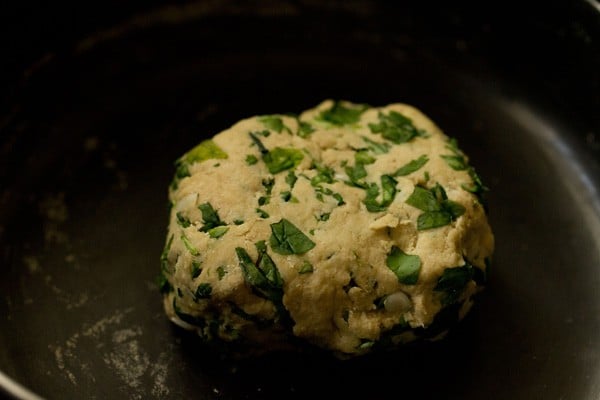
Roll Dough
5. Pinch medium-sized portions from the dough. Roll the dough between your palms to make a neat round ball of dough.
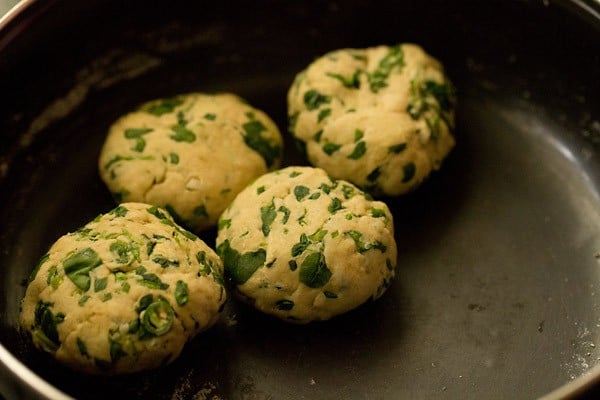
6. Lightly flatten the dough ball and keep it on the rolling board. Lightly dust the dough ball and the rolling board with some flour. Start rolling the paratha with a rolling pin.
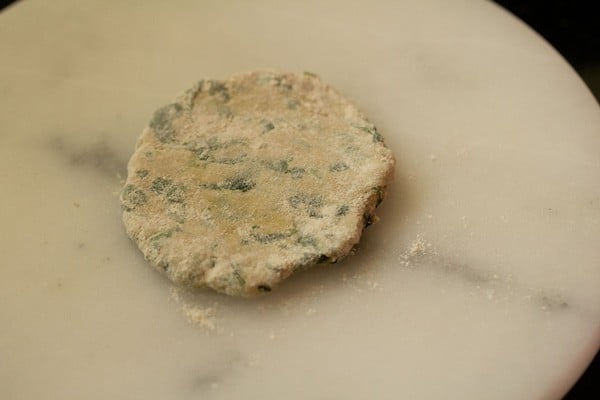
7. Roll the dough into medium-sized roti or circles having about 7 to 8 inches diameter, sprinkling flour as needed.
For a flaky, crispy layered paratha, spread ghee/oil all over and fold twice into a triangle shape. Then roll into a triangular shaped paratha dusting flour lightly.
The layering method with ghee or oil adds more fat in your parathas, but if you want a simple lighter version, then roll them plain with brushing any fat on the dough as I have done.
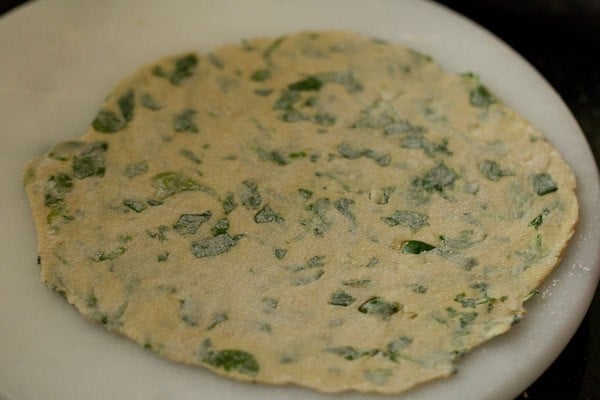
Make Methi Paratha
8. Place the paratha on a hot skillet or tawa. Keep the heat to medium-high or high before you place the paratha on it. The tawa has to hot before you start making the paratha.
Tip: To check the hotness of the skillet, sprinkle a pinch of flour on it. If the flour browns in a few seconds, the skillet is hot enough for roasting paratha. Wipe this roasted flour on the skillet with a kitchen napkin before placing the paratha.
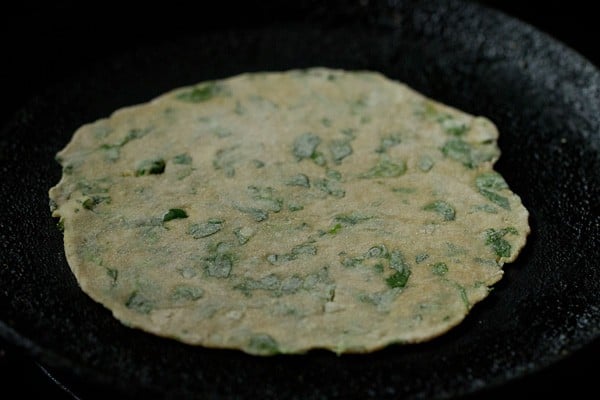
9. When one side is a bit cooked or about ¼ cooked, flip it. You will see some air pockets beginning to form on the paratha.
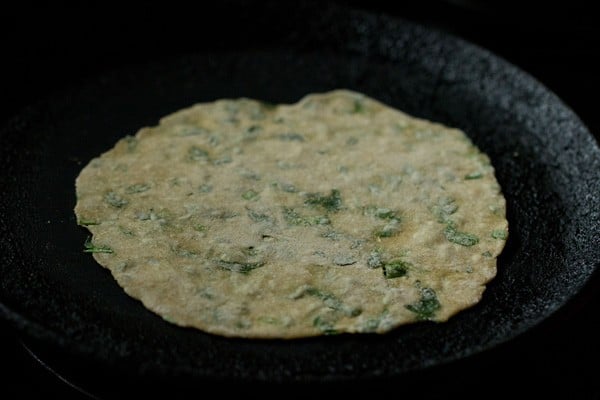
10. Spread oil or ghee (clarified butter) on this side that is facing you. Use any neutral oil or peanut oil for roasting.
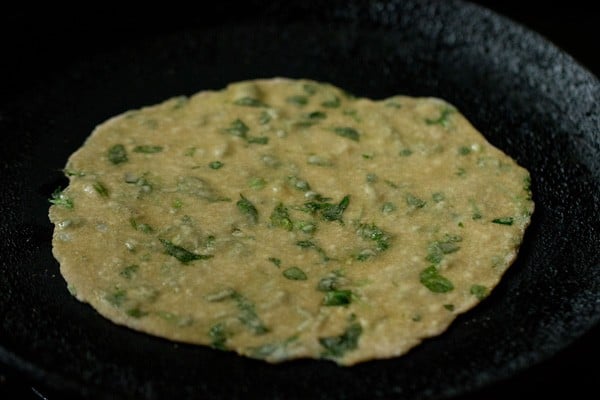
11. Flip again and you should see some brown or golden spots on the paratha. Spread ghee on this side which has the golden spots.
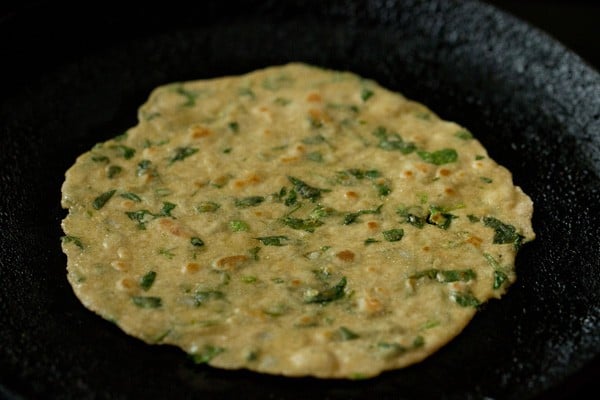
12. Flip again a couple of times until the methi paratha is evenly cooked and has golden spots or blisters. Press the edges with a spatula so that they get cooked well.
While making the second paratha don’t forget to wipe the skillet with a kitchen napkin if there is any excess whole wheat flour on it.
Roll the remaining dough balls and roast all methi parathas this way on a hot skillet or tawa.
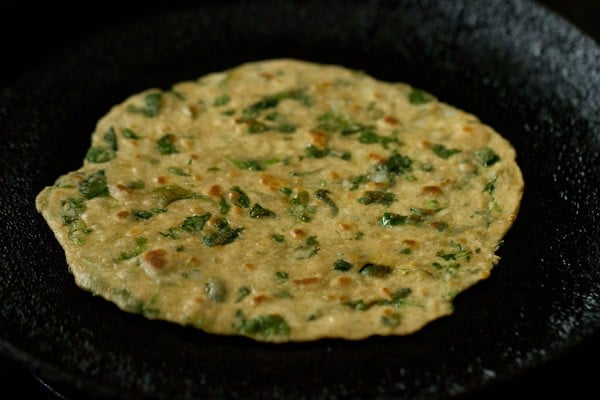
Serving Suggestions
Methi paratha is best served hot. However, it can be served warm or at room temperature. You can also stack them in a roti basket or casserole box/container.
Easily enjoy for breakfast, lunch, or at dinner. My favorite things to serve with methi ka paratha are vegetable curries, sugar-sweetened yogurt, or pickles.
Some people like to have these methi roti with plain Curd (yogurt), Mango Pickle, Lemon Pickle, Red Chilli Pickle, Garlic Pickle or Green Chili Pickle. It all depends on your preference!
They can also be wrapped in foil and packed in lunch boxes or for short journeys. Methi ke parathe make a good tiffin box snack and stay soft when packed in a foil.
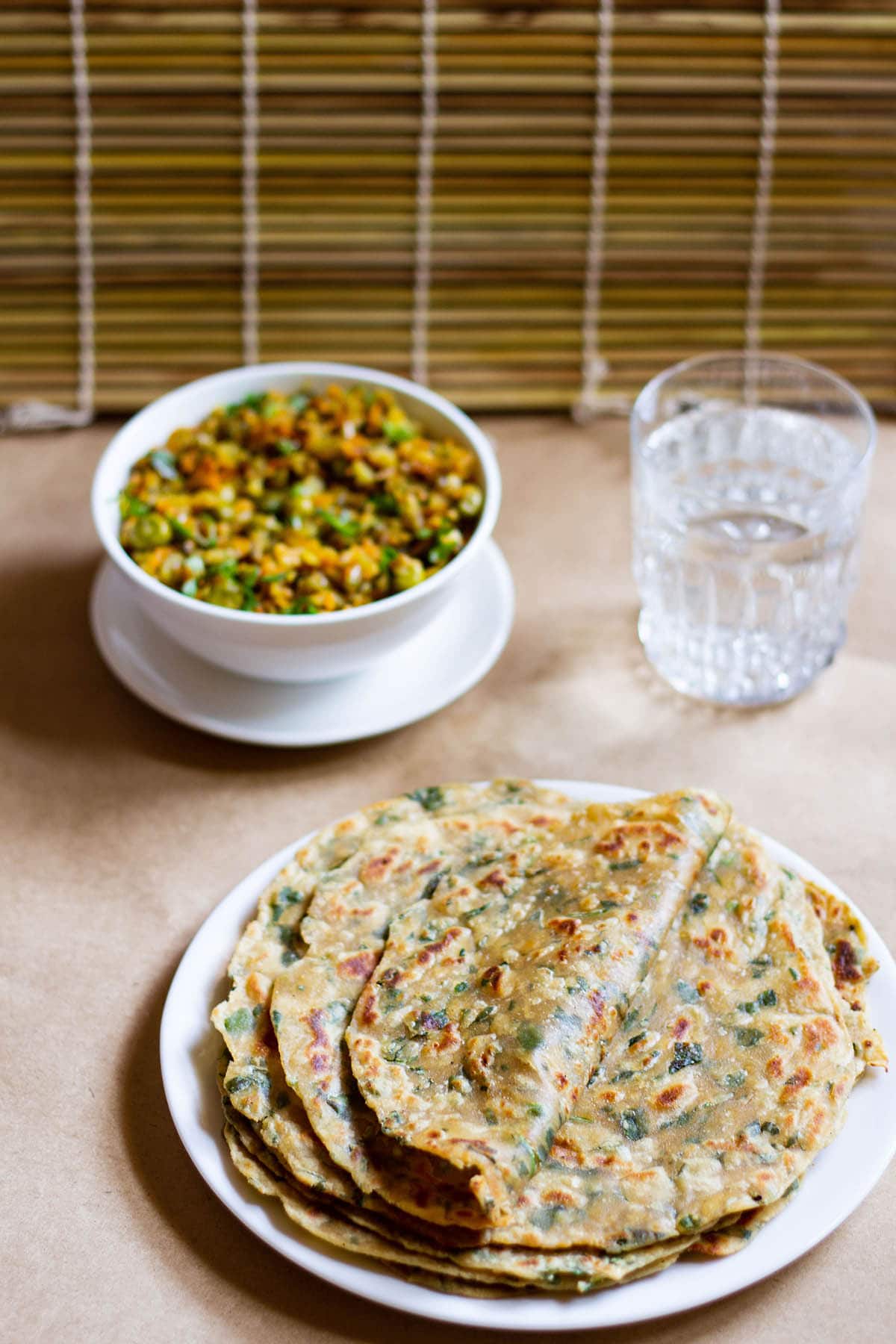
Expert Tips
- Substituting methi leaves: If you do not get methi leaves, then substitute spinach (palak) or amaranth (chaulai – green or red leaves). The taste will be different and the parathas won’t have the unique methi flavor, but nevertheless, they will be healthy and nutritious.
- Swapping with dried fenugreek leaves: Kasuri methi or dried fenugreek leaves are a great option for fresh ones. I often use kasuri methi when I do not have fresh fenugreek leaves to make these methi roti. Include 2 to 3 tablespoons of kasuri methi to make your methi paratha recipe.
- Roasting tips: Ensure that your skillet or tawa is hot. Roast parathas on medium-high to high heat. Roast paratha on low heat would make them undercooked or chewy and hard. A very high heat would cause the parathas to burn. Regulate the heat as needed when roasting.
- Heat: If you like spicy food then feel free to add more chilies to this methi paratha recipe. Conversely, if you are not too fond of chilies then you can add less.
- Add-ins: Bring more flavors in your methi paratha recipe by including finely chopped onions, minced ginger or ginger-garlic paste. Opt to add ground spices like turmeric powder, garam masala powder, cumin powder, coriander powder, red chilli powder to make a spiced flavorsome methi roti.
FAQs
Yes, you can definitely use dried fenugreek in this recipe. You will need to add 2 to 3 tablespoons of dried fenugreek leaves to the whole wheat flour and follow the remaining steps of the recipes as normal. The dried fenugreek leaves will give the methi ke parathe a slightly different flavor and taste compared to the fresh fenugreek leaves.
Methi paratha is made with fenugreek, herbs, and spices while methi thepla includes gram flour (besan), curd (yogurt), and plenty of spices. The besan gives the thepla a nutty taste and the curd adds a delicious rich flavored sour taste.
Remove the fenugreek leaves from the stem as soon as you buy the fenugreek. Then thoroughly wash the leaves and dry them. Once the leaves are dry put them in a container or zip lock bag and refrigerate.
I keep my plucked methi leaves in a steel container and they usually stay fresh for 4 to 5 days. It’s very convenient for when I want to sprinkle methi leaves on pakoras, pulao, and dal to add some flavor. For more advice about cleaning methi read this Aloo Methi recipe post!
More Tasty Paratha Recipes!
North Indian Food Recipes
Breakfast Recipes
Breakfast Recipes
Breakfast Recipes
Please be sure to rate the recipe in the recipe card or leave a comment below if you have made it. For more vegetarian inspirations, Sign Up for my emails or follow me on Instagram, Youtube, Facebook, Pinterest or Twitter.
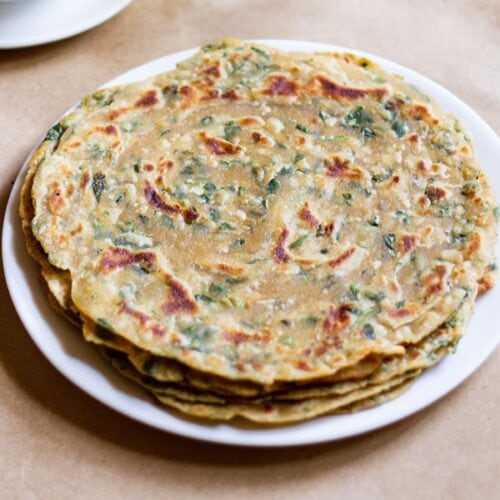
Methi Paratha Recipe (Punjabi Methi ke Parathe)
Ingredients
- 2 cups whole wheat flour – 240 grams
- 1 cup methi leaves (fenugreek leaves), tightly packed, not chopped
- ½ to 1 teaspoon finely green chilies or 1 to 2 green chillies
- 1.5 teaspoons finely chopped garlic or 7 to 8 small to medium-sized
- 2 teaspoons oil or Ghee – use any neutral oil or peanut oil
- ⅓ cup water or add as required
- ½ teaspoon salt or as required
- Ghee (clarified butter) or oil, as required for roasting
Instructions
Prepping Methi Leaves
- Place the fenugreek leaves in a bowl filled with water and to which ½ teaspoon baking soda and 1 tablespoon vinegar has been added.
- Soak for about 2 to 3 minutes, later draining all the water.
- Soak the leaves in clean water for a couple of minutes. Swish and move the leaves gently with your fingers. This removes any soil or mud particles that are on the stems or leaves.
- Drain the water again. You can repeat this process of soaking and draining once or twice or choose to thoroughly rinse the leaves under running water for a few times. Finally, drain the water well.
- Place the leaves on a kitchen towel and spread them evenly on it for a few minutes or you can proceed to chopping them.
Kneading Dough
- In a bowl mix the whole wheat flour and salt.
- Add the chopped methi leaves, green chilies, garlic, oil and mix again.
- Pour water little by little and mix the dough first. Later knead to a smooth and soft dough adding water as needed.
- Note that the water proportion will vary with the water content in the fenugreek leaves and the type, variety of wheat flour.
- Tip 1: If the dough looks sticky, add a few tablespoons of whole wheat flour and knead again.
- Tip 2: If the dough looks dry or dense, add a couple of tablespoons of water and continue to knead.
Rolling dough
- Pinch medium sized balls from the dough. Roll them between your palms to make a neat round ball.
- Flatten the dough ball and dust it lightly with some flour and the rolling board as well.
- With a rolling pin, roll the dough into medium sized roti or circle having 7 to 8 inches diameter.
- For a flaky, crispy layered paratha, spread ghee all over and fold twice into a triangle shape. Then roll them to a large triangle shaped dough sprinkling flour lightly.
- The layering method with ghee adds more fat in your parathas, but if you want a simple lighter version, then roll them plain with brushing any ghee on the dough as done in this recipe.
Roasting
- Heat a skillet or tawa on medium-high to high heat. Place the rolled methi paratha on a hot tawa or griddle.
- Tip: To check the hotness of the skillet, sprinkle a pinch of flour on it. If the flour browns in a few seconds, the skillet is hot enough for roasting paratha.Wipe this roasted flour on the skillet with a kitchen napkin before placing the paratha on it.
- When one side is a bit cooked or about ¼ cooked, flip the paratha. You will see some air pockets beginning to form on paratha.
- Spread some oil or ghee (clarified butter) on the side that is facing you.
- Flip again and you should see some brown or golden spots on the paratha. Spread ghee on this side having the golden spots.
- Flip again a couple of times, until the paratha is evenly roasted and has some golden spots or blisters. Press the paratha edges with a spatula so that they get cooked.
- Roll the remaining dough balls and make the methi parathas this way. While making the second paratha don’t forget to wipe the skillet with a kitchen napkin if there is any excess whole wheat flour on it.
Serving Suggestions
- Methi paratha is best served hot. However, it can be served warm or at room temperature. You can also stack them in a roti basket or casserole box/container.
- Easily enjoy for breakfast, lunch, or at dinner. My favorite things to serve with methi ke parathe are vegetable curries, sweetened curd, or pickle.
- Some people like to have parathas with plain curd (yogurt), mango pickle, lemon pickle, or green chili pickle. It all depends on your preference!
- They can also be wrapped in foil and packed in lunch boxes or for short journeys. Methi roti make a good tiffin box snack and stay soft when packed in a foil.
Notes
- Substituting methi leaves: If you do not get methi leaves, then substitute spinach (palak) or amaranth (chaulai- green or red). The taste will be different and the parathas won’t have the unique methi flavor, but nevertheless, they will be healthy and nutritious.
- Swapping with dried fenugreek leaves: Kasuri methi or dried fenugreek leaves are a great option for fresh ones. I often use kasuri methi when I do not have fresh fenugreek leaves to make these methi roti. Swap with 2 to 3 tablespoons of kasuri methi.
- Roasting tips: Ensure that your skillet or tawa is hot. Roast parathas on medium-high to high heat. Roasting paratha on low heat would make them undercooked or chewy and hard. A very high heat would cause the parathas to burn. Regulate the heat as needed when roasting.
- Heat: If you like spicy food then feel free to add more chilies to this recipe. Conversely, if you are not too fond of chilies then you can add less.
- Add-ins: Bring more flavors in your methi paratha by including finely chopped onions, minced ginger or ginger-garlic paste. Opt to add ground spices like turmeric powder, garam masala powder, cumin powder, coriander powder, red chilli powder to make spiced flavorsome methi ke parathe.
Nutrition Info (Approximate Values)
Methi Paratha recipe from the blog archives first published on Jan 2013. It has been updated on December 2024.
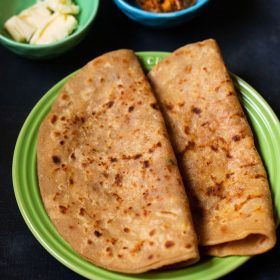
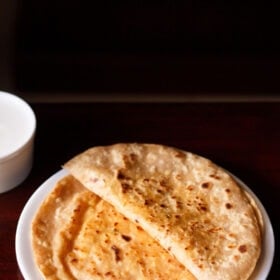
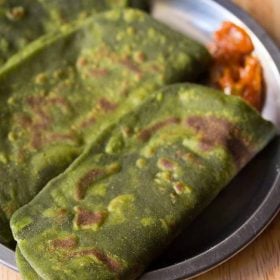
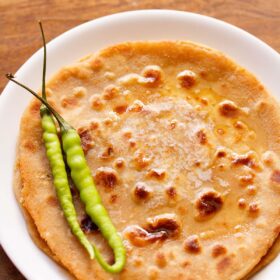
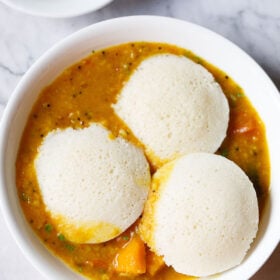
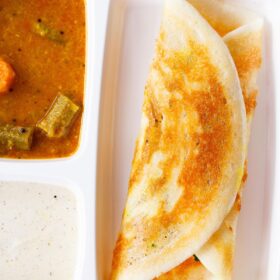
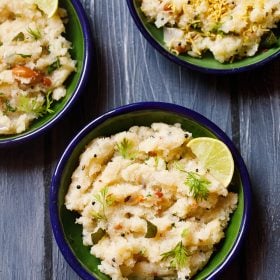








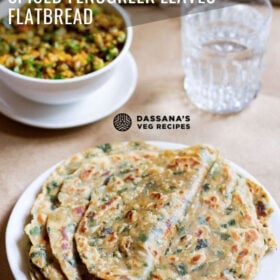
Thanks for the recipe:)
Welcome Pavana
SINCE THE NAME OF THIS RECIPE IS METHI PARATHA, AND NOT METHI THEPLA……WE HAVE TO ROLL DOUGH SAME WAY WE ROLL PLAIN PARATHAS..
YOUR RECIPES ARE EXCELLENT. THANKS FOR SHARING.
yes. thanks and welcome.
Thanks for sharing. It was nice. Kids loved it. But parata was not too soft little hard. May be could have added more water. Any tips to make it soft.
Welcome Bhuvi. The paratha dough has to be smooth and soft. otherwise methi parathas won’t be soft. Yes you could have added some more water.
Add some hot oil while making dough
Thanks for the recipe. I find your recipes easy to follow. I have one suggestion and one request here. Please insist the readers to wash the methi leaves thoroughly such that the mud in the leaves get washed off. I made this paratha yesterday. Although it came out soft, much of it were served to crows as there were grains of mud in every bite. ????
Please also tell how to wash methi leaves. They are too tiny for me to handle.
anuradha, welcome and thanks for the suggestion. i do not usually mention cleaning methi leaves as most indian women know how to clean and rinse the leaves. also the post becomes lengthy. usually the leaves are plucked from the stems.
the leaves are usually on the top and do not have mud clinging on them. the muds clings on the roots or on the lower parts of the stems. even if you rinse the leaves 3 to 4 times in water the mud gets rinsed away.
always use the leaves and not the stems. tender stems are fine to use. take the leaves in a colander or a in a large bowl. if using a colander then under running water rinse the leaves.
if using a bowl then fill the bowl with water and keep methi leaves in it for a few minutes. the mud settles at the bottom. then invert the bowl carefully and drain all the water. repeat the process 3 to 4 times. in the methi mushroom recipe post, i have shared a detailed method of cleaning methi leaves.
Thank you for sharing. I have question. Can we saute methi and then add to atta? Is that ok?
by sautéing methi, some flavors will be lost and then again the methi gets cooked when making parathas. so i would suggest to add fresh methi leaves.
Hi!! As usual u rock everytime ..I love Methi paratha instead of curd or any other dish I go with garlic pickle or if u dnt hve pickle I make garlic cloves with oil and some masala like oil chili powder salt and tomato finely chopped mix with garlic cook till u see the oil ozzes out goes best with methi paratha.. Hope u like it I shared my experience.. Thnk you for ur delicious recipes..
Welcome Fazila. Nice to know this. Thanks for sharing your positive feedback and your garlic pickle recipe. I am sure someone will try the pickle recipe you shared here.
Hi,
Which Sabzi goes well with Methi Paratha..Please Suggest…
Sharvani, you can serve with aloo sabzi, aloo gobi, pumpkin sabzi or aloo matar sabzi.
Hello Amit,I have always followed ur receipes…
The step by step photo procedure is very good and it gives clarity…..
Thanks again…Looking forward for some more delicious receipes from u to write and me to follow…????
Welcome Amruta. Thanks for your positive feedback on recipes.
Hi Dassana…. tried most of your methi recipes…. they all came out very well & was appreciated by everyone at home.
Thanks Bindu for sharing your positive feedback on methi recipes.
Hiii dasanna…I tried most of your re eipes..and went out awesome..my husband liked it very much…for mehi paratha can we make dough at night…
Thanks Akshatha. You can make the dough at night.
Do we have to let the dough rest for sometime ?
no need shruti. if you keep the dough to rest, then the methi leaves release more moisture and the dough can get sticky.
Nice
Super breakfast food
thank you.
super recipe
thankyou bala 🙂
Easy to cook.receipe is simple.
thankyou girija 🙂